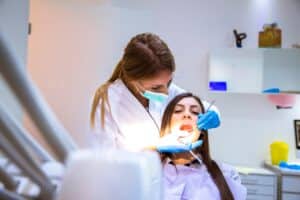Setting out on the quest for a straighter, more confident smile is a thrilling choice, yet the selection of the most suitable method can be a formidable challenge. In the realm of orthodontics, two widely embraced alternatives take the spotlight: Invisalign and traditional braces. Within this thorough exploration, we will delve into the advantages and disadvantages of each, casting a spotlight on the factors that will guide you toward an enlightened decision. Let’s plunge into the details with the expertise of an Invisalign dentist in mind!
Understanding Invisalign And Traditional Braces From An experienced Invisalign dentist
Invisalign:
Invisalign is a modern approach to straightening teeth using a series of custom-made, clear aligners. These aligners are virtually invisible, making them an attractive option for those who wish to undergo orthodontic treatment discreetly. Crafted from comfortable, smooth plastic, Invisalign aligners are removable, allowing for easy maintenance of oral hygiene and the flexibility to eat without restrictions.
Traditional Braces:
Traditional braces, on the other hand, consist of metal brackets affixed to each tooth and connected by wires. This time-tested method is effective in treating various orthodontic issues, from mild to severe. While traditional braces are fixed and not removable, they come in a variety of colors, allowing wearers to express their personality.
Pros of Invisalign
Aesthetic Appeal:
Invisalign takes the lead in terms of aesthetics. The clear aligners are barely noticeable, providing a discreet orthodontic solution. This is especially appealing to individuals who may be hesitant about the appearance of traditional braces.
Removability:
The ability to remove Invisalign aligners facilitates easier oral care. Brushing and flossing are less cumbersome, reducing the risk of plaque buildup and cavities during the treatment process.
Comfort:
Invisalign aligners are made from smooth plastic, eliminating the discomfort and potential irritation caused by wires and brackets. This makes the treatment more comfortable for the wearer.
Dietary Freedom:
Those who wear Invisalign have the flexibility to eat anything they want. The aligners are removable during meals, eliminating restrictions on certain foods that can pose challenges for those with traditional braces.
Cons Of Invisalign
Compliance:
Success with Invisalign relies heavily on patient compliance. The aligners must be worn for 20-22 hours a day to achieve optimal results. For forgetful individuals or those tempted to remove the aligners frequently, this could hinder the effectiveness of the treatment.
Treatment Limitations:
Severe orthodontic cases might not be appropriate candidates for Invisalign. Complex issues may require the precision and control that traditional braces offer.
Cost:
Treatment with Invisalign is typically more costly than braces. While the aesthetic benefits may justify the cost for some, financial considerations are crucial in the decision-making process.
Pros of Traditional Braces
Effectiveness:
Traditional braces are highly effective for correcting a wide range of orthodontic issues. They provide precise control over tooth movement, making them suitable for complex cases.
Predictable Outcome:
With traditional braces, the orthodontist has more control over the treatment process. This predictability can be reassuring for both the orthodontist and the patient, ensuring a successful outcome.
No Compliance Dependency:
Unlike Invisalign, where success relies on consistent wear, traditional braces are always working. There’s no need to worry about forgetting to put aligners back in after meals or when brushing.
Cons of Traditional Braces
Aesthetics:
Traditional braces’ most obvious disadvantage is their visibility. The metal brackets and wires may be a deterrent for individuals who prefer a more discreet option.
Oral Hygiene Challenges:
Cleaning around brackets and wires can be challenging, requiring additional effort and care to maintain optimal oral hygiene during treatment.
Discomfort:
Traditional braces can cause discomfort and irritation, especially during the initial adjustment period and after routine tightening appointments.
Choosing the Right Option For You
Considerations:
Orthodontic Needs:
The kind and severity of your orthodontic problems are important factors in choosing the best course of action. Consultation with an experienced orthodontist will help assess which option aligns better with your specific needs.
Lifestyle:
Your lifestyle and daily routines should be considered. If the flexibility of removing aligners fits well with your lifestyle, Invisalign may be the preferred choice.
Budget:
Financial considerations are essential. While Invisalign offers aesthetic advantages, it may come at a higher cost. Traditional braces, though visible, can be a more budget-friendly option.
Personal Preference:
Your personal preferences and comfort level with each treatment option should not be overlooked. Feeling at ease with your choice enhances the likelihood of a positive orthodontic experience.
Humanizing The Experience
Deciding on orthodontic treatment is a personal journey, and understanding the human aspect of this decision is crucial. Your orthodontic team, including your Invisalign dentist or traditional braces orthodontist, plays a vital role in guiding and supporting you throughout the process.
The Role of An Invisalign Dentist:
Choosing an experienced Invisalign dentist ensures that you receive the best possible care during your treatment journey. These professionals are trained to assess your unique needs, create a personalized treatment plan, and provide guidance on proper aligner usage.
Humanizing the experience means fostering open communication with your Invisalign dentist. Express any concerns or questions you may have, and work collaboratively to achieve the best results. Remember that your journey to a straighter smile is a partnership, and your input is valuable.
The Traditional Braces Orthodontist:
If you opt for traditional braces, your orthodontist becomes a key figure in your orthodontic journey. Regular check-ups, adjustments, and discussions about your progress are integral components of the relationship.
Humanizing the experience involves building trust and rapport with your orthodontic team. Feel free to discuss any discomfort, share your preferences for braces colors, and celebrate milestones along the way. Your orthodontist is there to support you throughout the process.
In the grand scheme of things, both Invisalign and traditional braces are effective methods for achieving a beautifully aligned smile. As you weigh the pros and cons, remember that the human aspect of orthodontic treatment is just as important as the technicalities. Your smile is a unique expression of yourself, and the journey to enhance it should be a positive and fulfilling experience. Whether you choose Invisalign or traditional braces, embrace the opportunity to work closely with your orthodontic team, and revel in the transformative power of a confident, radiant smile.




